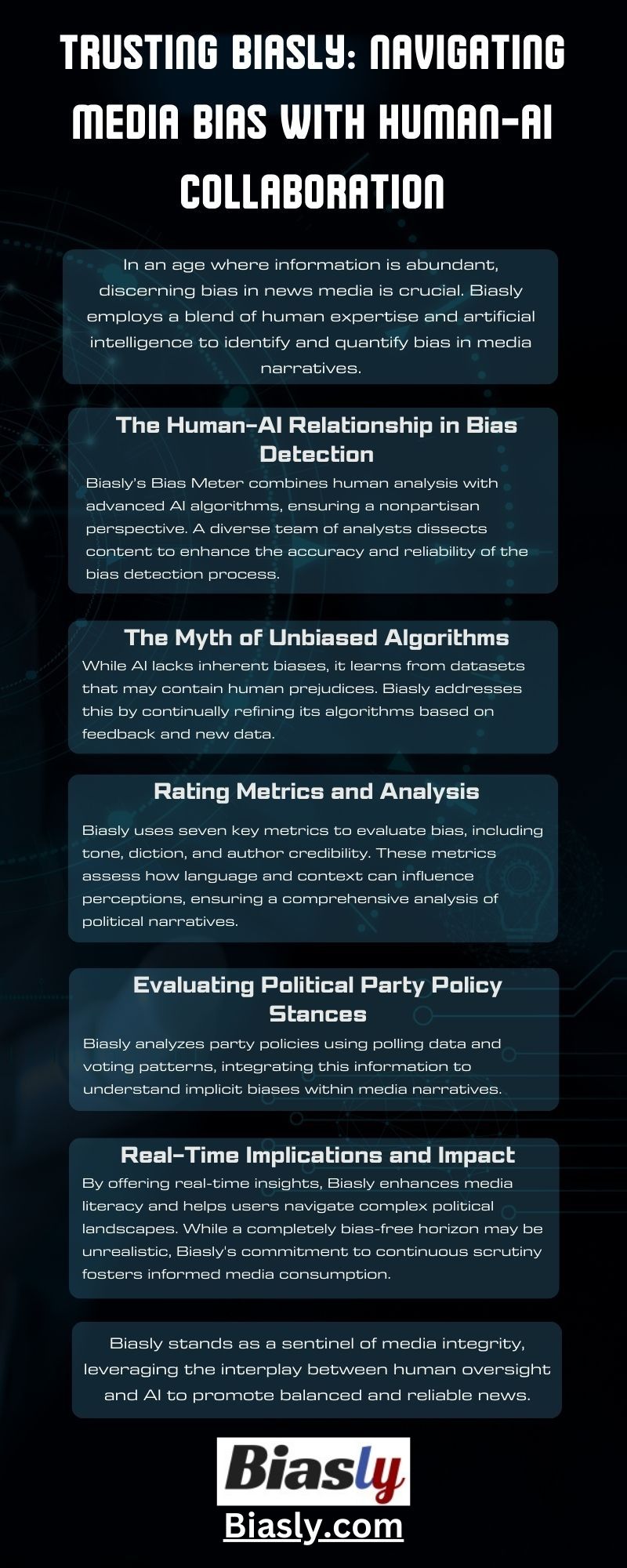
Biasly’s Ratings: The Science Behind the Data
Navigating the labyrinth of media bias, Biasly stands as a beacon of objectivity, cutting through the fog of partisan discourse. Harnessing sophisticated A.I. (artificial intelligence) coupled with rigorous human evaluation, Biasly meticulously unravels the complexities of media bias. It delves beneath the veneer of reporting, critically examining the sentiments and sources that mold public discourse. This analytical pioneer transcends simple political labels, opting for a nuanced journalistic integrity analysis. In doing so, Biasly reveals the intricate spectrum of impartiality and bias that characterizes the contemporary media environment.
Bias Rating: Every article on Biasly receives a score that ranges from -100% for liberal bias to 100% for conservative bias, with 0% representing a neutral or center stance. When you visit the individual article rating page on Biasly, you can delve deeper into the components of this bias score, examining how the author portrays specific politicians and policies and how these elements contribute to the overall bias rating. This comprehensive approach ensures that the score reflects a multifaceted analysis of ideological leanings, considering various factors, including political figures and policy coverage, all of which see integration into the final bias rating.
Reliability Factors: Beyond just bias, Biasly’s A.I. assesses the article’s reliability based on several parameters:
- Sources: Their quantity, quality, and ideological tendencies
- Quotes: Their length and number reflect the balance between the author’s voice and external sources.
- Viewpoints: We evaluate articles to include diverse perspectives, especially opposing ones, highlighting the publication’s commitment to balanced reporting.
- Author Bias: A crucial aspect. Understanding an author’s historical leanings can provide context to the current piece.
Politician and Policy Analysis: By quantifying sentiment towards politicians and policies, readers gain insight into how news outlets might frame specific figures or issues.
Analyst Ratings: The Human Touch
While A.I. provides a robust, systematic approach to reliability, we must recognize the human touch. Analyst ratings bring in the nuance, the context, and the depth of understanding that machines, as advanced as they are, might miss. These evaluations provide another layer to the reliability score, ensuring the outcomes are comprehensive and trustworthy.
What Does the A.I. Do?
Let’s illustrate this with a hypothetical scenario:
Let’s consider an article that explores a fresh policy proposition made by a politician. The A.I. system meticulously scans the article, paying attention to various elements. Firstly, it notes that the article utilizes a broad range of sources. For example, this could mean references to numerous reputable news outlets, quotes, etc. This diversity of sources adds credibility to the information presented.
Next, the A.I. notes that the article includes several quotes of considerable length. These quotes could be statements directly from the politician proposing the policy, experts in the field offering analysis, or individuals affected by the proposed policy sharing their perspectives. Including these varied voices adds depth and balance to the article, further elevating its reliability.
Lastly, the A.I. considers historical data about the author. It notes that the author’s past work has exhibited a neutral stance, indicating a consistent effort to present information impartially rather than swaying towards a particular bias.
Considering all these factors, the A.I. determines a reliability score for the article. Given the diversity of sources, including comprehensive quotes, and the author’s history of neutrality, the A.I. assigns a high-reliability score to this article, indicating its trustworthiness and balanced presentation of information.
How Biasly Produces Its Ratings
In the analysis of the article titled “Hundreds of Thousands March in London for Palestinians,” Biasly has assigned an 18% “Somewhat Conservative” bias rating. The rating derives from evaluating specific components within the article, including the framing of topics like Palestinian nationalism and the portrayal of political figures and policies. Biasly’s algorithms quantify the article’s leanings on the political spectrum by assessing the diversity and representation of sources and the extent and context of quoted material.
Likewise, Biasly gave another article, “Major pro-Palestinian march staged in London as police ramp up security – The Boston Globe,” a “Center” bias rating of 10%. This assessment reflects a near-neutral stance in the article’s presentation. Biasly’s rating derives from multiple factors, including the reliability of the sources, the balance in policy leaning, and the portrayal of politicians.
The article includes slightly conservative sentiments, such as a negative sentiment toward the Black Lives Matter protests, which contributes to a conservative bias. However, it also has antagonistic views toward far-right politician Tommy Robinson, contributing to a liberal bias. Combining these sentiments and evaluating the sources and quotes within the article results in a centrist bias rating. Biasly’s methodology aims to quantify such nuances to provide a more informed understanding of an article’s overall bias.
Chrome Extension
Application in Social Media
In today’s fast-paced digital age, staying informed is more important than ever. But with the avalanche of information comes the risk of misinformation. Enter Biasly and its game-changing Chrome extension: the Biasly News Check, which strives to set a gold standard for assessing news reliability.
Biasly News Check’s Chrome extension, grounded in state-of-the-art data science, deploys an intricate A.I. system to scan, analyze, and rate news articles for bias and reliability.
Biasly’s commitment to reliable news continues beyond traditional websites. The Chrome extension seamlessly integrates with social media platforms like Facebook and Twitter, ensuring you can differentiate fact from slant even as you scroll through your feed.
What is the Chrome Extension Used For?
Whether you’re an educator hoping to teach media literacy, a politician gauging public sentiment, or an everyday netizen striving for an informed worldview, Biasly’s Chrome Extension is your ally.
Getting Started
To get started using the Biasly News Check Chrome extension, please follow these steps:
- Install the Chrome extension.
- Register on Biasly.com (it’s free!).
- Pin the extension to your browser.
- Start browsing and let Biasly guide you to more informed reading.
In sum, the synthesis of cutting-edge A.I. technology and human analysis makes Biasly’s News Check Chrome Extension a pioneering tool in the fight against misinformation. As readers, it’s essential to consume information and understand its quality. With Biasly, we’re one step closer to a more informed, discerning world.























